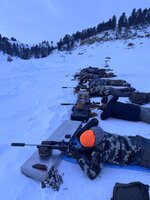EastHumboldt
WKR
- Joined
- Nov 14, 2020
- Messages
- 1,761
At the range today a snow squall blew in and got all my stuff sprinkled with snow. It was just barely warm enough that it turned into water droplets right away. It was getting pretty snotty but I wanted one last five round group. I loaded five rounds from the box into a magazine, and took five more shots. The ammo had a few droplets on it, but I’ve shot under these conditions before so I wasn’t worried. The last two rounds, I had hard bolt lift and noticeable extractor swipe marks. I’ve fired probably 120 rounds of this particular hand load prior with no pressure signs, so I was surprised.
I don’t know if I’ve never seen this before, or just never noticed it before. I’ve been hunting for 40 years often in snotty weather.
I looked it up when I got home and found an article explaining why it happens. Who knew it’s a thing! I understand now what the science is, but I don’t understand why the first 3 rounds were fine and the last 2 were hot.
Anyone else experience this?
I don’t know if I’ve never seen this before, or just never noticed it before. I’ve been hunting for 40 years often in snotty weather.
I looked it up when I got home and found an article explaining why it happens. Who knew it’s a thing! I understand now what the science is, but I don’t understand why the first 3 rounds were fine and the last 2 were hot.
Anyone else experience this?


